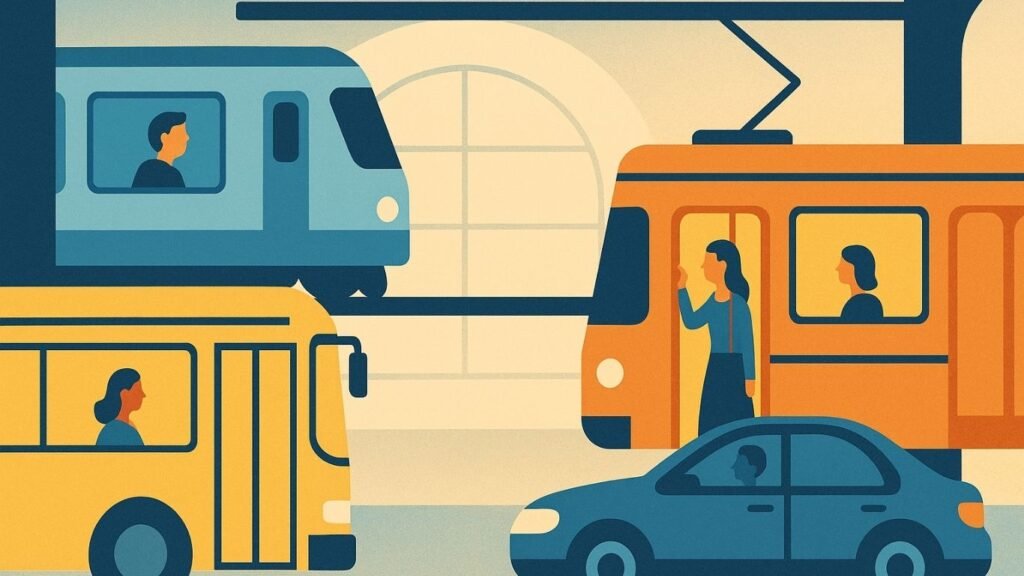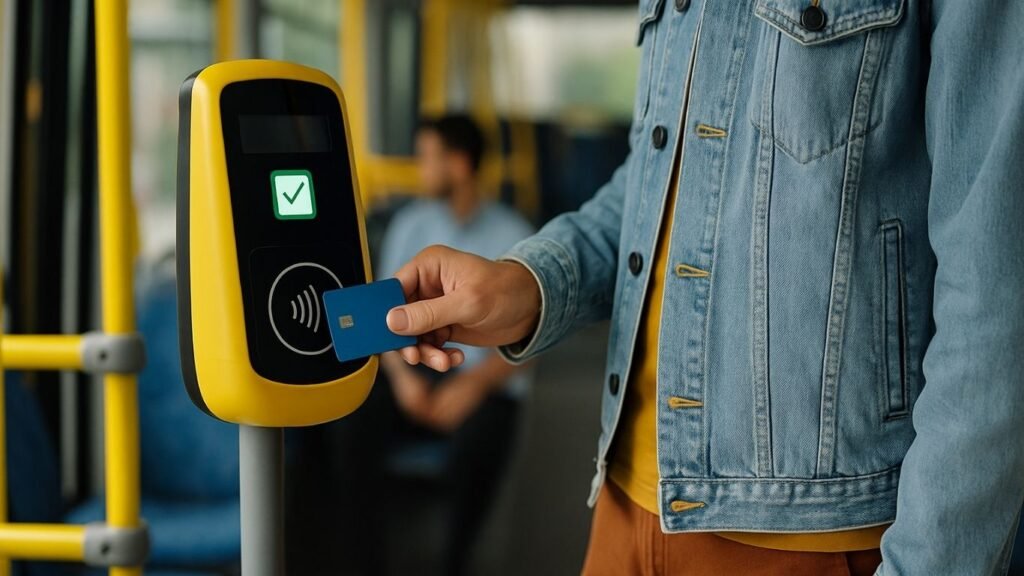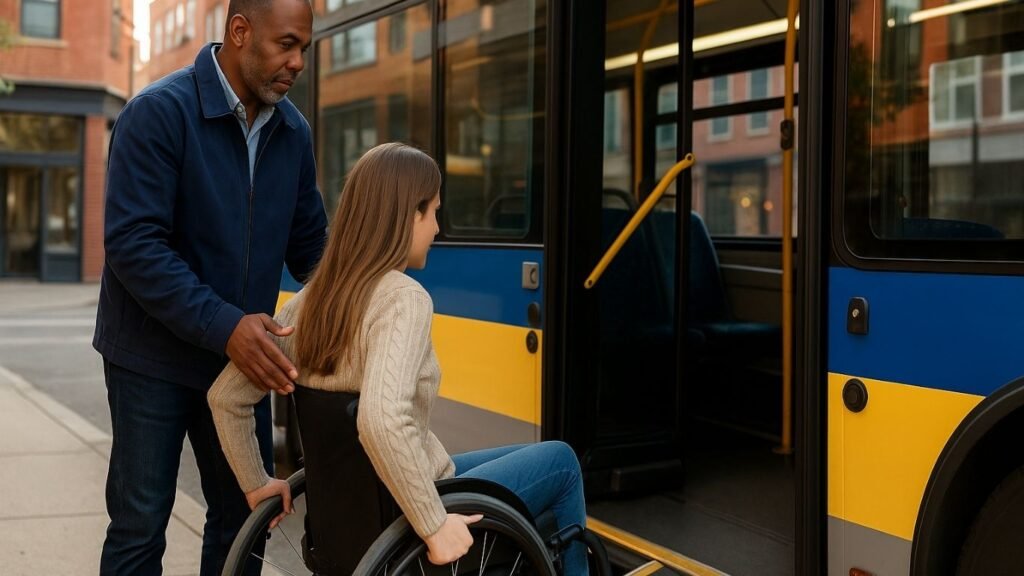Exploring North America’s cities means diving into a world shaped by diverse, dynamic public transit systems. Whether it’s the hum of New York’s subways or the glide of Vancouver’s ferries, knowing how to move like a local unlocks a deeper, more authentic experience.
This guide offers essential local transit tips for North America, blending detailed advice, insider insights, and expert strategies. From city-by-city navigation to planning your rides and understanding local etiquette, you’ll learn how to ride confidently, avoid common pitfalls, and explore more with ease.
Travel isn’t just about the destination—it’s about how you move through it. With these trusted local transit tips for North America, you’ll do more than get around—you’ll belong.
Table of Contents
Major Types of Public Transit in North America

Navigating North America’s sprawling cities and regions is easier than ever if you understand the major forms of public transportation available. Each system has its own rhythm, style, and significance, shaping the daily lives of millions. For travelers seeking the best local transit tips for North America, mastering these transportation methods is essential for moving efficiently, economically, and authentically.
Buses
Buses form the lifeline of many cities and rural communities across North America. In large metropolitan areas like Los Angeles, Mexico City, and Toronto, comprehensive bus networks offer extensive coverage, often connecting neighborhoods that other transit options miss.
Typically, city buses are affordable and frequent during peak hours. Systems such as Mexico City’s Metrobús or Los Angeles’ Metro Bus operate on dedicated lanes to avoid traffic snarls, offering a surprisingly swift alternative to driving. However, schedules may vary by day and time, especially on weekends and holidays, so it’s wise to check real-time apps or official transit websites before heading out.
For suburban or cross-city travel, you’ll often find express buses with limited stops, cutting travel time significantly. Learning how to identify express routes versus local ones can save precious hours during your journey—a critical piece of local transit wisdom for North America travelers.
Subways and Light Rail
Subways and light rail systems represent the fastest and most reliable public transit options within urban centers. New York City’s subway, the most iconic in North America, runs 24/7 and carries nearly six million passengers on a typical weekday. Similarly, Toronto’s TTC subway, Montreal’s Metro, and Mexico City’s Metro offer extensive underground networks connecting the heart of the city to its farthest neighborhoods.
Meanwhile, light rail systems like Vancouver’s SkyTrain and Seattle’s Link light rail combine the speed of subways with the scenic vistas of above-ground travel. Travelers seeking local transit tips for North America should note that many light rails offer direct connections to airports, making arrivals and departures seamless.
Streetcars and Trolleys
Few experiences are as charming—or as practical—as riding a historic streetcar. In cities like San Francisco, New Orleans, and Toronto, streetcars remain an essential part of daily commuting. San Francisco’s famous cable cars climb steep hills with mechanical grace, offering not just transportation but a memorable travel moment.
Modern streetcar systems have also reemerged in places like Portland and Atlanta, blending nostalgia with modern urban planning. Travelers should be aware that streetcar schedules can be less predictable during peak traffic hours, making patience and flexible planning key elements when using this transit form.
Ferries
In coastal cities, ferries are a quintessential part of the public transportation network. Vancouver’s SeaBus glides across Burrard Inlet, providing breathtaking views of the skyline, while New York City’s Staten Island Ferry offers a free and photogenic journey across New York Harbor.
Ferries are often overlooked in many local transit tips for North America, but savvy travelers know that these rides can be both practical and scenic. Some ferry routes even accept the same fare cards used on buses and trains, simplifying your travel experience.
Rideshares and Microtransit Options
While traditional taxis remain an option, the rise of rideshare services like Uber, Lyft, and DiDi has dramatically reshaped North American cityscapes. In some cities, government-supported microtransit services—essentially rideshares operated like minibuses—offer low-cost, flexible transportation that fills the gaps left by fixed-route buses and trains.
For visitors unfamiliar with local rideshare regulations, checking city-specific guidelines is crucial. In cities like Austin or Vancouver, certain rideshare companies dominate, while others may not operate at all. Microtransit pilot programs, like those in Los Angeles County and smaller towns across the U.S., are worth exploring for affordable, efficient travel.
When traditional routes fall short, mastering rideshare and microtransit is a game-changer—an often-overlooked gem among top local transit tips for North America.
City-by-City Tips for Navigating Local Transit

Each major city in North America has cultivated its own unique transit culture. Understanding these differences—and adapting to them quickly—can mean the difference between a stressful journey and an exhilarating one. For travelers gathering essential local transit tips for North America, mastering city-specific systems is key to moving seamlessly through urban landscapes.
New York City: Mastering the Subway and Bus Systems
No guide offering local transit tips for North America would be complete without mentioning New York City’s subway. With 472 stations and 27 lines, the subway operates 24 hours a day, seven days a week. It is the fastest and most affordable way to navigate the five boroughs.
Key tips:
- Use a MetroCard or OMNY: OMNY is the contactless system now expanding throughout NYC.
- Study express vs. local trains: Express trains skip multiple stops, a time-saver once you master the system.
- Avoid rush hours if possible: Trains become extremely crowded between 7–10 a.m. and 4–7 p.m.
Buses fill in where subways don’t reach, especially in outer boroughs like Staten Island and Queens. They accept MetroCards and OMNY as well, making transfers easy.
Toronto: TTC and Beyond
Toronto’s Toronto Transit Commission (TTC) manages subways, buses, and streetcars in Canada’s largest city. The subway system is reliable, but many downtown travelers often opt for the charming red streetcars.
Top local tips:
- Presto cards simplify fare payment across all modes.
- Streetcars run 24 hours on many routes—perfect for late-night travelers.
- Plan for delays: TTC occasionally experiences mechanical issues, especially during harsh winters.
While exploring Toronto, many travelers overlook suburban transit like GO Transit. However, integrating regional trains can make day trips to Niagara Falls or Hamilton seamless—a smart extension of savvy local transit tips for North America.
Mexico City: Metro and Metrobús Essentials
Mexico City’s Metro is both iconic and vast, boasting 12 lines and some of the lowest fares in the world. It’s one of Latin America’s largest and busiest systems, moving millions daily.
Key insights:
- Buy a rechargeable Metro Card to avoid fumbling with coins.
- Be cautious during peak hours: the system becomes extremely crowded.
- Metrobús (a Bus Rapid Transit system) uses dedicated lanes and can often outpace the Metro during rush hour.
For women travelers, the Metro offers women-only cars during busy times—a critical piece of local wisdom often missing from standard local transit tips for North America.
Vancouver: Seamless Travel with TransLink
Vancouver’s public transportation, operated by TransLink, is among the cleanest and most efficient in North America. The SkyTrain’s automated trains offer stunning views while zipping through the city.
Traveler essentials:
- Compass Cards: The universal fare card works on SkyTrain, buses, and SeaBus ferries.
- Zones affect fare prices, particularly during weekday peak hours.
- Bikes are welcome on SkyTrain during non-peak hours, an eco-friendly bonus.
Don’t miss the SeaBus for a scenic 12-minute ride across Burrard Inlet—a prime example of the rich experiences awaiting travelers who dig deeper for real local transit tips for North America.
Chicago: Riding the CTA Like a Pro
The Chicago Transit Authority (CTA) operates the “L” trains and bus networks, making it relatively simple to get around the Windy City.
Travel wisdom includes:
- Use a Ventra Card to streamline payments.
- Plan around weather: winter storms can delay service, especially on elevated tracks.
- The Red Line and Blue Line run 24/7, a rarity outside New York City.
Chicago’s logical grid system makes it easier for first-time visitors to grasp the transit network quickly, solidifying it as one of the top destinations for applying efficient local transit tips for North America.
Montreal: Navigating the Metro and STM Buses
Montreal’s Metro system, known for its rubber-tired trains, is compact but efficient, linking the city’s eclectic neighborhoods with minimal fuss.
Traveler notes:
- OPUS cards are the easiest way to pay fares.
- Signage is primarily in French; knowing basic phrases helps.
- Buses extend service to areas the Metro doesn’t cover—crucial for reaching suburban neighborhoods or cultural hotspots like Little Italy.
Montreal’s underground city, RESO, connects Metro stations downtown, providing a weatherproof way to explore in winter—a nuanced detail worth noting when offering comprehensive local transit tips for North America.
San Francisco: Balancing BART, Muni, and Cable Cars
Few cities offer as iconic a transit experience as San Francisco.
Here, three systems rule:
- BART (Bay Area Rapid Transit) connects the city with outlying areas like Oakland and Berkeley.
- Muni buses and streetcars cover local travel.
- Cable cars offer scenic (though tourist-heavy) rides over San Francisco’s dramatic hills.
Important local advice:
- Use a Clipper Card for all services.
- Cable cars are pricey ($8 per ride)—consider walking or using streetcars for regular travel.
- BART airport connections are cheaper and faster than taxis.
In San Francisco, the perfect mix of nostalgia and efficiency awaits those who know where to look, proving that refined local transit tips for North America can elevate any urban adventure.
How to Plan and Pay for Your Rides

Mastering local transit isn’t just about knowing where to catch the next bus or train; it’s about preparing in advance and understanding the tools that make urban navigation seamless. For travelers determined to ride like a local, planning and payment strategies are indispensable. When collecting the best local transit tips for North America, this step often separates the casual visitor from the confident explorer.
Best Apps and Maps to Use
In today’s digital age, mobile apps are the key to efficient transit experiences.
Several must-have tools can help you navigate routes, monitor arrival times, and even avoid service disruptions:
- Transit App: Covers real-time bus, train, and ferry information across dozens of North American cities.
- Citymapper: Particularly helpful for complex cities like New York, Toronto, and San Francisco. Offers route comparisons, travel times, and even scooter/bike-share options.
- Google Maps: A reliable classic, with updated transit schedules for most cities.
- Moovit: Great for planning trips and checking for last-minute delays, especially in smaller cities.
Savvy travelers know that downloading at least two apps ensures a backup if one service experiences outages—a subtle but smart addition to essential local transit tips for North America.
Understanding Transit Passes and Fare Cards
Every major city in North America has its own system of fare payment, and knowing which option saves you money is crucial.
Some key insights:
- Unlimited passes: Cities like New York (MetroCard), Chicago (Ventra), and Vancouver (Compass) offer day, week, or month passes that pay for themselves quickly if you plan heavy sightseeing.
- Stored-value cards: You preload money and tap or swipe as you go, automatically deducting the correct fare.
- Single-ride tickets: Best for infrequent travelers, though they are often more expensive per trip than bulk options.
A common mistake travelers make is assuming transit passes work across all systems. In reality, many cities maintain separate agencies. For instance, San Francisco’s BART and Muni require linked but distinct fare structures—a nuanced detail that reinforces the importance of curated local transit tips for North America.
Contactless Payment and Mobile Ticketing
Modern systems have embraced contactless technology to streamline boarding.
Here’s what to expect:
- OMNY in New York, Presto in Toronto, and Compass in Vancouver now allow you to tap debit cards, smartphones, or smartwatches directly at fare gates.
- Mobile ticketing apps: Some transit systems (like Dallas’ DART or Denver’s RTD) enable you to buy tickets right from your phone without handling paper tickets.
- Contactless limits: Some older buses or suburban rail systems might still require traditional paper tickets, especially in less urbanized areas.
Knowing whether you can board with just your phone—or if you’ll need cash or a card—can make or break a seamless journey. Paying attention to mobile ticketing is one of the fastest-growing local transit tips for North America that new travelers should embrace.
Local Etiquette and Safety Tips

Public transportation in North America is an extraordinary window into local culture—yet with every system comes a unique set of unspoken rules. Knowing how to behave and stay safe is just as important as mastering maps or payment methods. Whether riding subways in New York or buses in Vancouver, these refined local transit tips for North America will ensure you blend in, stay secure, and travel smart.
Common Do’s and Don’ts
Every transit system thrives on a rhythm, and locals appreciate travelers who adapt quickly.
Some essential do’s and don’ts include:
Do:
- Stand to the right on escalators, especially in busy stations like Washington D.C.’s Metro or Toronto’s TTC.
- Give up priority seating for seniors, people with disabilities, and pregnant individuals.
- Have your fare ready before boarding to avoid holding up the line.
Don’t:
- Block doors: Move into the vehicle once you board to allow others behind you to enter.
- Play loud music: Always use headphones.
- Eat or drink on vehicles where it’s prohibited (such as Montreal’s Metro).
These behaviors aren’t just about courtesy—they’re vital to fitting in when applying expert local transit tips for North America.
Staying Safe on Public Transit
Although public transit across North America is generally safe, it’s important to stay alert, especially in unfamiliar environments.
Key safety tips include:
- Keep bags zipped and close: Pickpocketing is rare but possible during crowded rush hours.
- Stay in well-lit areas when waiting for late-night buses or trains.
- Trust your instincts: If a situation feels unsafe, move to a busier car or change your seat.
In major hubs like Chicago, New York, and Mexico City, many transit authorities maintain visible police or security patrols on trains and platforms, enhancing safety. However, using common sense remains a critical part of applying trustworthy local transit tips for North America.
Handling Strikes, Delays, and Unexpected Changes
Transit strikes, construction delays, and unexpected service changes are occasional realities, especially in cities like Montreal or San Francisco.
Preparation is key:
- Sign up for service alerts via apps or SMS updates where available.
- Always have a backup route planned: Knowing nearby bus routes or alternative lines can be invaluable.
- Allow extra travel time if you have important appointments or flights.
Handling disruptions gracefully is part of traveling like a seasoned explorer. Those who embrace these contingency strategies will find that even detours and delays can offer unexpected discoveries—one of the most underrated yet important local transit tips for North America.
Special Transit Tips for Travelers
While many cities offer reliable and efficient public transportation, travelers often face unique challenges that locals don’t. Whether riding late-night subways or navigating with children in tow, applying customized local transit tips for North America can significantly enhance your experience.
Late-Night and Weekend Transit
Public transit schedules often shift dramatically after regular business hours.
Here’s what to know:
- Reduced service frequency: In cities like Los Angeles and Toronto, expect longer waits for buses and subways late at night.
- Night buses: Some systems operate special “Night Owl” services (like San Francisco’s All-Nighter buses) that cover major routes after rail service ends.
- Stay visible and alert: Always wait in well-lit, populated areas, and if possible, choose vehicles with other passengers.
Knowing late-night schedules ahead of time is a practical and often overlooked piece of local transit tips for North America—one that can save you from expensive taxis or dangerous situations.
Transit Tips for Families and Groups
Traveling with a group or young children changes how you approach public transit:
- Family passes: Many cities offer discounted group travel options, like Chicago’s CTA group passes or Vancouver’s Family Travel Program, where children ride free with an adult on weekends.
- Stroller etiquette: Fold strollers when boarding buses or subways to make space for others—a courteous and expected practice.
- Plan shorter trips: Kids (and adults!) often tire quickly in crowded systems, so break journeys into manageable segments.
Applying these family-focused local transit tips for North America ensures smoother rides and happier adventures for everyone.
Accessibility and Services for Travelers with Disabilities
North American transit systems vary widely in their accessibility levels.
Important insights include:
- Elevator access: While newer systems like Vancouver’s SkyTrain are fully accessible, older systems like New York’s subway can be more challenging, with limited elevator availability.
- Low-floor buses: Common across most cities, these buses lower themselves at stops to allow easy boarding.
- Paratransit services: Specialized vans and shuttles serve travelers with disabilities in cities like Toronto, Chicago, and Los Angeles—usually requiring advance booking.
A thorough understanding of accessibility options is crucial for creating comprehensive local transit tips for North America that genuinely serve every traveler.
Alternatives When Transit Isn’t an Option
Even the most meticulously planned transit journey can sometimes hit a roadblock—limited schedules, maintenance disruptions, or simply a desire for more freedom. Fortunately, North America’s cities offer a wealth of alternative transportation options. For travelers curating the best local transit tips for North America, knowing when and how to pivot is key to staying mobile and stress-free.
Walking-Friendly Cities
Many North American cities are surprisingly walkable, especially downtown cores.
- New York City, Boston, Montreal, and San Francisco boast high Walk Scores, meaning you can easily access shops, attractions, and restaurants by foot.
- Safety first: Always use designated crosswalks, especially in sprawling cities where jaywalking is strictly enforced (like Los Angeles).
- Weather awareness: Pack accordingly—heat, snow, or rain can dramatically affect walkability.
Incorporating walking into your daily itinerary not only saves money but also provides deeper, street-level insights—a bonus hidden within thoughtful local transit tips for North America.
Biking and Bike-Share Programs
Bicycles have surged in popularity across North American cities, driven by an emphasis on eco-friendly transport.
Key options include:
- Citi Bike in New York City
- Divvy Bikes in Chicago
- BIXI in Montreal
- Mobi in Vancouver
Tips for success:
- Check for bike lanes: Cities like Portland and San Francisco have dedicated, protected bike lanes for safer riding.
- Use helmet rentals or bring your own: Not all bike-share programs provide helmets.
- Plan for docking stations: Knowing where you can return your bike is crucial, especially during peak hours when docks fill up.
Bike-share programs aren’t just a backup; they’re an integral, active part of savvy local transit tips for North America, offering speed, flexibility, and a little adventure.
Affordable Car Rentals and Car-Sharing Apps
Sometimes public transportation isn’t feasible—late-night travel, remote destinations, or heavy luggage might necessitate a car.
Modern alternatives include:
- Turo and Zipcar: Ideal for short-term rentals without the hassle of traditional rental counters.
- Car2Go and similar services: Perfect for quick city trips with one-way drop-off options.
- Electric vehicle (EV) rentals: Becoming more common in eco-conscious cities like San Francisco, Vancouver, and Los Angeles.
When renting, always check parking regulations and toll fees ahead of time. Missteps can lead to costly fines—a pitfall easily avoided by adding smart rental strategies to your collection of expert local transit tips for North America.
Final Thoughts: Ride Like a Local and Explore More
Mastering the intricacies of public transportation across North America is more than just a matter of logistics—it’s an invitation to experience each city’s heartbeat. Every metro ride, bus trip, ferry crossing, or streetcar journey offers a window into local life, hidden corners, and spontaneous adventures. Following the best local transit tips for North America transforms you from an outsider navigating maps into a traveler moving intuitively through vibrant urban landscapes.
The beauty of North American transit systems lies in their diversity. In one trip, you might ride a century-old cable car in San Francisco, glide over waterways on Vancouver’s SeaBus, and dive underground into the world’s busiest subway network in New York City. Yet despite their differences, all systems reward travelers who approach them with preparation, respect, and a spirit of curiosity.
By embracing these expert local transit tips for North America, you gain more than mobility—you gain a deeper, richer connection to the cities you visit. You learn their rhythms, respect their rules, and uncover stories that taxi windows and tourist buses can never offer.
Ride like a local. Move like you belong. And in doing so, you’ll not just visit North America—you’ll live it.
FAQ
What’s the best way to save money on public transit in North America?
Purchasing unlimited passes or stored-value cards often yields the best savings. Cities like New York, Toronto, and Chicago offer discounted weekly or monthly passes that can dramatically cut costs if you’re riding multiple times a day. Smart local transit tips for North America always recommend planning your rides in advance to choose the best fare options.
Is public transportation safe in major North American cities?
Generally, yes. Most public transit systems prioritize rider safety, and major hubs are patrolled by security personnel. Staying aware of your surroundings, avoiding empty stations late at night, and keeping valuables secure are simple practices that align with top local transit tips for North America for safety.
Are there apps that help navigate North American transit systems?
Absolutely. Apps like Transit, Citymapper, Moovit, and Google Maps provide real-time updates, route planning, and alerts about delays. Following tech-savvy local transit tips for North America means always having at least one transit app installed before you arrive.
How do I know if a city’s public transit system is accessible?
Many cities have dedicated resources highlighting accessibility options. Systems like Vancouver’s TransLink and Chicago’s CTA offer detailed accessibility maps and services. Researching in advance is one of the smartest local transit tips for North America to ensure seamless travel for all.
List of North American rapid transit systems
